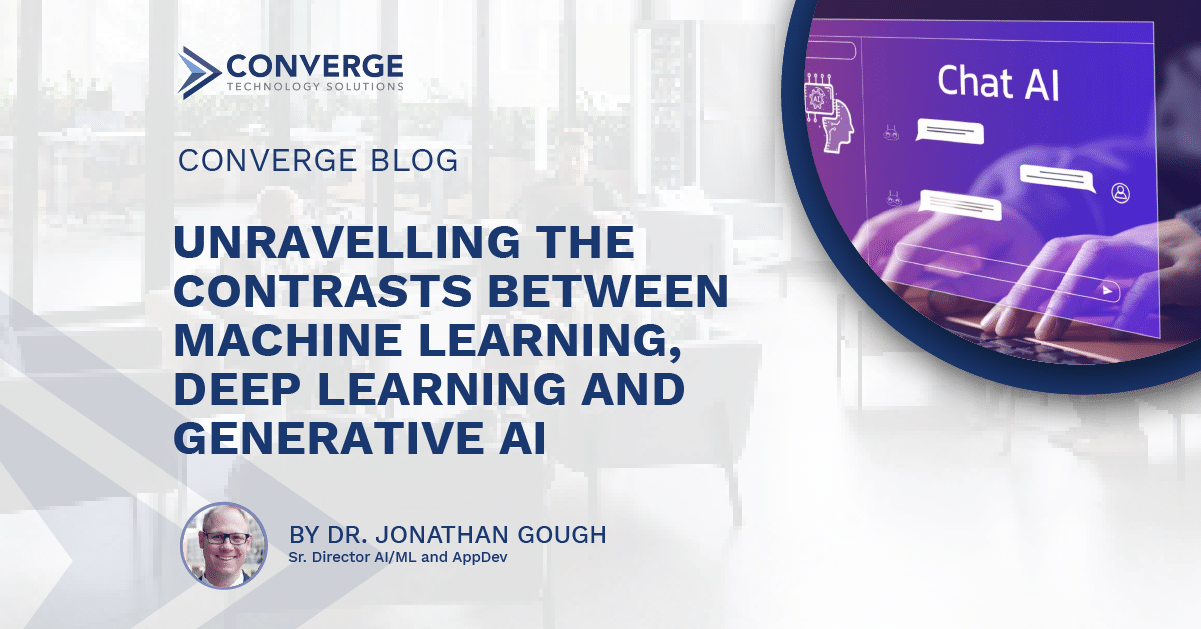In the past 6 months Generative AI has exploded, most notably via OpenAI’s “ChatGPT.” In recent years, the fields of Machine Learning (ML) and Deep Learning (DL) have gained significant attention and have become buzzwords in the technology industry (Generative AI is a subset of DL). ML and DL are subsets of Artificial Intelligence (AI) and are used to automate processes, predict outcomes, and gain insights from data. Despite their similarities, there are significant differences between them. In this article, we will explore the major differences between ML and DL.
Supervised vs Unsupervised Learning
One of the significant differences between Machine Learning and Deep Learning is the type of learning that each uses. ML algorithms use supervised or unsupervised learning methods. In supervised learning, the algorithm is trained on labelled datasets, meaning the input data has a specific output assigned to it.
For example, an algorithm can be trained on images of cats and dogs labelled as such, and then it can be used to predict if a new image contains a cat or a dog. On the other hand, unsupervised learning algorithms are used when the input data does not have any specific output assigned to it. Instead, the algorithm is used to find patterns and relationships in the data.
In DL, the algorithms use a type of supervised learning known as deep neural networks. These networks consist of multiple layers of interconnected nodes designed to process data hierarchically.
Each layer of the network extracts features from the input data, and these features are then used by the next layer to further refine the output. DL algorithms can learn from unstructured data, such as images, audio, and text, and can be used for tasks such as image recognition, speech recognition, and natural language processing.
Data Requirements
Another significant difference between Machine Learning and Deep earningL is the amount and type of data required to train the algorithms. ML algorithms typically require a large amount of structured data to be trained effectively. Structured data is organized in a predefined format, such as a table with columns and rows. For example, a machine learning algorithm used for credit scoring would require a large dataset of historical credit data to make accurate predictions.
DL algorithms, on the other hand, can work with both structured and unstructured data and can learn from smaller datasets. This is because DL algorithms are designed to automatically extract features from the input data, which can help to reduce the amount of data required to train the algorithm effectively. For example, a DL algorithm for image recognition can be trained on a relatively small dataset of images and still provide accurate predictions.
Interpretability
One of the limitations of Deep Learning algorithms is their lack of interpretability. Because deep neural networks are designed to learn from data independently, it can be difficult to understand how they make decisions. This lack of interpretability can be problematic in applications where the decisions made by the algorithm need to be explained to end-users or stakeholders.
In contrast, ML algorithms are typically more interpretable because they are designed to make decisions based on specific rules or criteria. For example, a decision tree algorithm can be easily explained because it makes decisions based on a series of if-then statements.
Accuracy and Performance
Deep Learning algorithms are known for their high accuracy and performance in tasks such as image recognition and natural language processing. This is because deep neural networks can learn complex patterns and relationships in the data that may be difficult for other algorithms to detect. However, DL algorithms can be computationally expensive and may require specialized hardware to achieve high accuracy and performance.
Machine Learning algorithms, on the other hand, may not be as accurate or performant as DL algorithms but are generally faster and require less computational resources. ML algorithms can still be effective in tasks such as predictive modelling and anomaly detection.
But What about Generative AI?
The ability to generate text (ChatGPT) or images (Dall-E) has captured the attention of nearly everyone. The intuitive effectiveness of ChatGPT has moved the needle in terms of understanding the reality of AI. From creating creating silly poems to writing emails the power and business value is tangible.
Fundamentally, Generative AI are Deep Learning models that generate text, images, or code when given text or images as input. These models are trained on a very large sets of data (e.g. significant portions of the internet). They aren’t explicitly taught any grammar or rules, or image styles or definitions. Instead, they read in massive amounts of data (text or images) and figure out patterns all by themselves (in an unsupervised manner). As part of the training process, they trained to generate output responses that resembles what it has seen previously.
Generative AI uses a blend of supervised learning (predicting the next word in a sentence, given the previous words) and unsupervised learning (figuring out the structure of the language without explicit instructions or labels). They are like voracious readers, absorbing vast amounts of text data, and learning the rules and patterns of language along the way, all without a teacher explicitly telling them what to learn.
Conclusion
Machine Learning and Deep Learning are both subsets of Artificial Intelligence and have significant differences in their learning methods, data requirements, hardware requirements, interpretability, and accuracy and performance. Understanding these differences can help organizations choose the best approach for their specific use case. Machine Learning can be effective for tasks that require interpretable algorithms and smaller datasets, while Deep Learning can be effective for tasks that require high accuracy and performance on unstructured data.
Generative AI is still in it’s infancy but is growing exponentially. It’s impact on work and productivity will be seismic. If your organization is looking for a reliable partner to assist in implementing Generative AI in your workstreams, Look no Further than Converge Technology Solutions! With our 10 year history in building and deploying AI, ML and DL solutions, we can help your business thrive in today’s ever-evolving technology landscape.
Contact us today to learn more: jonathan.gough@convergetp.com




